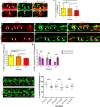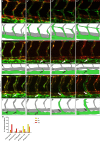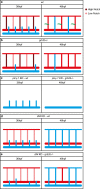The adaptor protein Grb2b is an essential modulator for lympho-venous sprout formation in the zebrafish trunk
- PMID: 33677657
- PMCID: PMC8205915
- DOI: 10.1007/s10456-021-09774-w
The adaptor protein Grb2b is an essential modulator for lympho-venous sprout formation in the zebrafish trunk
Abstract
Vegfc/Vegfr3 signaling is critical for lymphangiogenesis, the sprouting of lymphatic vessels. In zebrafish, cells sprouting from the posterior cardinal vein can either form lymphatic precursor cells or contribute to intersegmental vein formation. Both, the Vegfc-dependent differential induction of Prox1a in sprouting cells as well as a Notch-mediated pre-pattern within intersegmental vessels have been associated with the regulation of secondary sprout behavior. However, how exactly a differential lymphatic versus venous sprout cell behavior is achieved is not fully understood. Here, we characterize a zebrafish mutant in the adaptor protein Grb2b, and demonstrate through genetic interaction studies that Grb2b acts within the Vegfr3 pathway. Mutant embryos exhibit phenotypes that are consistent with reduced Vegfr3 signaling outputs prior to the sprouting of endothelial cells from the vein. During secondary sprouting stages, loss of grb2b leads to defective cell behaviors resulting in a loss of parachordal lymphangioblasts, while only partially affecting the number of intersegmental veins. A second GRB2 zebrafish ortholog, grb2a, contributes to the development of lymphatic structures in the meninges and in the head, but not in the trunk. Our results illustrate an essential role of Grb2b in vivo for cell migration to the horizontal myoseptum and for the correct formation of the lymphatic vasculature, while being less critically required in intersegmental vein formation. Thus, there appear to be higher requirements for Grb2b and therefore Vegfr3 downstream signaling levels in lymphatic versus vein precursor-generating sprouts.
Keywords: Angiogenesis; Development; Lymphangiogenesis; VEGFR3; Vasculature; Zebrafish.
Conflict of interest statement
The authors declare no competing interests.
Figures









Similar articles
-
MicroRNA-126a Directs Lymphangiogenesis Through Interacting With Chemokine and Flt4 Signaling in Zebrafish.Arterioscler Thromb Vasc Biol. 2016 Dec;36(12):2381-2393. doi: 10.1161/ATVBAHA.116.308120. Epub 2016 Oct 27. Arterioscler Thromb Vasc Biol. 2016. PMID: 27789478
-
mafba is a downstream transcriptional effector of Vegfc signaling essential for embryonic lymphangiogenesis in zebrafish.Genes Dev. 2015 Aug 1;29(15):1618-30. doi: 10.1101/gad.263210.115. Genes Dev. 2015. PMID: 26253536 Free PMC article.
-
Ccbe1 regulates Vegfc-mediated induction of Vegfr3 signaling during embryonic lymphangiogenesis.Development. 2014 Mar;141(6):1239-49. doi: 10.1242/dev.100495. Epub 2014 Feb 12. Development. 2014. PMID: 24523457
-
A fisheye view on lymphangiogenesis.Adv Anat Embryol Cell Biol. 2014;214:153-65. doi: 10.1007/978-3-7091-1646-3_12. Adv Anat Embryol Cell Biol. 2014. PMID: 24276893 Review.
-
Pathway-related molecules of VEGFC/D-VEGFR3/NRP2 axis in tumor lymphangiogenesis and lymphatic metastasis.Clin Chim Acta. 2016 Oct 1;461:165-71. doi: 10.1016/j.cca.2016.08.008. Epub 2016 Aug 12. Clin Chim Acta. 2016. PMID: 27527412 Review.
Cited by
-
The modes of angiogenesis: an updated perspective.Angiogenesis. 2023 Nov;26(4):477-480. doi: 10.1007/s10456-023-09895-4. Epub 2023 Aug 28. Angiogenesis. 2023. PMID: 37640982 Free PMC article.
-
Pathological angiogenesis: mechanisms and therapeutic strategies.Angiogenesis. 2023 Aug;26(3):313-347. doi: 10.1007/s10456-023-09876-7. Epub 2023 Apr 15. Angiogenesis. 2023. PMID: 37060495 Free PMC article. Review.
-
Lymphatic vessel: origin, heterogeneity, biological functions, and therapeutic targets.Signal Transduct Target Ther. 2024 Jan 3;9(1):9. doi: 10.1038/s41392-023-01723-x. Signal Transduct Target Ther. 2024. PMID: 38172098 Free PMC article. Review.
-
Silver Nanoparticles Exposure Impairs Cardiac Development by Suppressing the Focal Adhesion Pathway in Zebrafish.Int J Nanomedicine. 2024 Sep 9;19:9291-9304. doi: 10.2147/IJN.S476168. eCollection 2024. Int J Nanomedicine. 2024. PMID: 39282573 Free PMC article.
-
Regulation of VEGFR Signalling in Lymphatic Vascular Development and Disease: An Update.Int J Mol Sci. 2021 Jul 20;22(14):7760. doi: 10.3390/ijms22147760. Int J Mol Sci. 2021. PMID: 34299378 Free PMC article. Review.
References
-
- Le Guen L, Karpanen T, Schulte D, Harris NC, Koltowska K, Roukens G, Bower NI, van Impel A, Stacker SA, Achen MG, Schulte-Merker S, Hogan BM. Ccbe1 regulates Vegfc-mediated induction of Vegfr3 signaling during embryonic lymphangiogenesis. Development. 2014;141(6):1239–1249. doi: 10.1242/dev.100495. - DOI - PubMed
-
- Jeltsch M, Jha SK, Tvorogov D, Anisimov A, Leppanen VM, Holopainen T, Kivela R, Ortega S, Karpanen T, Alitalo K. CCBE1 enhances lymphangiogenesis via A disintegrin and metalloprotease with thrombospondin motifs-3-mediated vascular endothelial growth factor-C activation. Circulation. 2014;129(19):1962–1971. doi: 10.1161/CIRCULATIONAHA.113.002779. - DOI - PubMed
Publication types
MeSH terms
Substances
LinkOut - more resources
Full Text Sources
Other Literature Sources
Molecular Biology Databases
Research Materials
Miscellaneous

